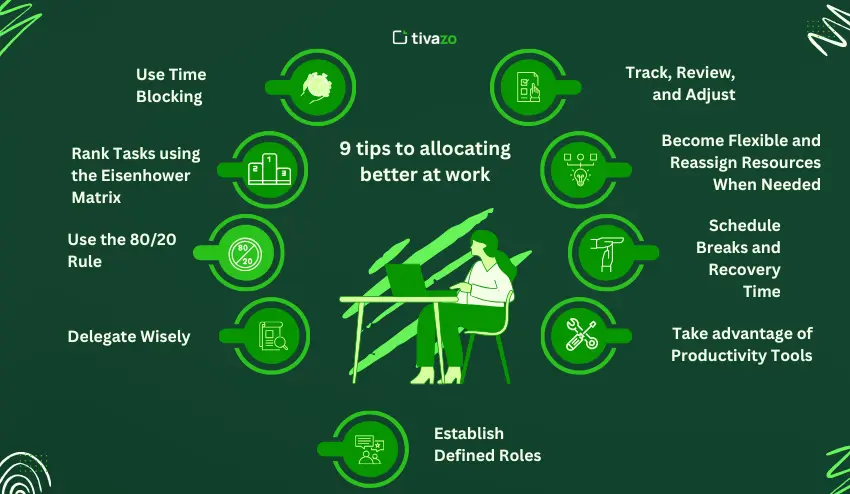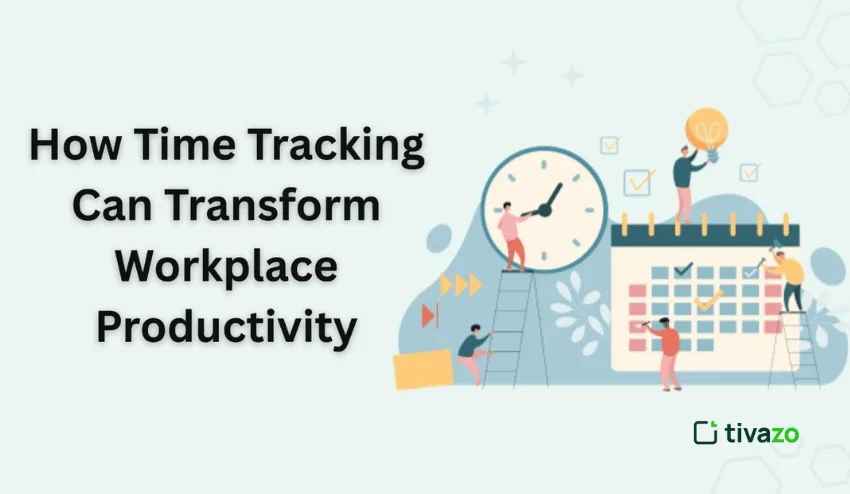Have you ever left a workday feeling like you were on the move all day and you still had not gotten the things done that were of utmost importance? That’s a common problem in many workplaces, and the root issue usually comes down to allocating.
At its core, allocation is about dividing your time, energy, and responsibilities so that the right things get done at the right time. In the workplace, allocating is what helps teams avoid burnout, managers keep projects moving, and employees focus on meaningful work instead of getting lost in endless small tasks.
Without proper allocation, it’s easy to spend the day reacting, jumping from emails to meetings to unexpected requests while real priorities get pushed aside. However, when time, work and resources are planned, the work place will be more organized, more productive and much less stressful.
This blog will explore what allocating really means in a workplace setting, why it’s critical for productivity, and how you can start applying proven strategies to manage your time and tasks more effectively. By the end, you’ll see how allocating can turn a hectic workday into a structured one where progress feels natural instead of forced.
What Is Allocating in the Workplace?

In the simplest terms, allocating in the workplace is about distributing resources, time, and responsibilities in a way that ensures work gets done smoothly. Imagine it to be the foundation of productivity, without correct distribution, even the most professional team may find itself wasting time or duplicating work.
In a modern workplace, allocation doesn’t just apply to money or equipment. It also involves time management, balancing of workloads, and assignment of tasks. An example is that a manager may assign certain tasks to the team members depending on their strength, or an organization may assign a budget for the tools that enhance collaboration.
When properly allocated, it will avoid burnout, increase efficiency, and ensure that workers remain concentrated on high-value activities rather than being caught in the mess. That is, it is not merely a matter of resource allocation- it is a matter of doing so in a strategic way to ensure maximum productivity in the workplace.
What is allocating in a workplace?
Simply put, allocating means distributing resources, time, and responsibilities to ensure work runs smoothly. Without allocation, even the best team will lose time or create duplication.
Allocating is not only about money or items. It also encompasses:
- Time management – recognizing the time needed to allocate to tasks, meetings or projects.
- Task assignments – finding the right people to work on a job, given their skills and availability.
- Balancing workload – ensuring that there are no overworking and under-utilized individuals.
- Space allocation – desks, meeting rooms, or digital tools to optimize your efficiency.
When done correctly, allocation does not just:
- Reduce employee stress and burnout.
- Improve productivity and appropriate work accomplishment.
- Keep teams focused on high-value work instead of the chaos.
Overall, allocating in a workplace is not just dividing resources, but rather doing so strategically to create a more productive and organized workplace!
Types of Allocating in the Workplace
Allocating at work isn’t one-size-fits-all. There are different forms of allocation that assist in controlling different facets of productivity. Knowledge of these types facilitates the effective allocation of tasks, time and resources.

1. Time Allocation
It is concerned with the choice of time to be devoted to particular tasks or projects. Effective time management will avoid spending time on low-priority tasks and will keep the priority on high-impact activities. It can be facilitated with the help of such tools as calendars, time-blocking, and trackers.
2. Task Allocation
Task allocation is a process that involves allocating duties to the appropriate team members according to their capabilities, availability, and workload. This will make sure that work is done in an efficient manner and make employees feel secure in their work.
3. Priority Allocation
Tasks are not all equally important. The priority allocation is aimed at the identification of the most urgent tasks and their priority. The teams can be assisted to differentiate between the urgent and important work by such techniques as the Eisenhower Matrix.
4. Workspace Allocation
This category means the arrangement of physical or digital resources. Examples include allocating desks, meeting rooms, software licenses, or shared equipment. The right allocation of workspaces will minimize the bottlenecks and ensure a smooth workflow.
5. Resource Allocation
Beyond time and tasks, allocating resources involves distributing materials, tools, or budget needed to complete work. Good resource allocation will make sure that projects are well equipped without wasting resources or spending too much.
Every form of allocation contributes to increasing productivity. When properly done, they establish a working environment where employees understand their roles, possess the appropriate tools and are able to concentrate on the activities that really matter.
9 tips to allocating better at work.
Effective allocation does not only involve distributing tasks randomly but it is more about being strategic in distributing time, responsibilities and resources in order to achieve productivity. This is a detailed handbook to nine effective strategies.

1. Use Time Blocking
Time blocking involves allocation of certain blocks of time to certain tasks or activities. This will avoid distractions filling your day and will make sure that important work gets attention.
Example: A software developer reserves 9-11 a.m. to code, 11-11.30 a.m. to respond to emails and 2-3 p.m. to hold a team meeting. By allocating these slots intentionally, the developer can focus deeply without interruption.
Hack: Use color-coding to separate the types of activities you do on your calendar, such as deep work, meetings, breaks, etc. that way, it is easy to see where your time goes. This will aid in avoiding the over-allocation of resources in one sector and under-allocation in another.
2. Rank Tasks using the Eisenhower Matrix.
Not everything is equally important. The Eisenhower Matrix can be used to put effort into focus in terms of urgency and impact. Activities are classified into four quadrants: urgent and important, important but not urgent, urgent but not important and neither.
Example: A manager will put client escalations (urgent and important) above the internal report updating (less urgent). Allocating effort this way ensures the team focuses on what moves the needle.
Tip: Check your task list once a week to redistribute it with a change in priorities. This will avoid the small low-value tasks that in the long run can eat up too much energy.
3. Use the 80/20 Rule (Pareto Principle).
The 80/20 rule holds that about 20 percent of the work will produce 80 percent of the results. Allocating more time and resources to these high-impact activities ensures maximum productivity.
Example: A marketing team finds out that 20% of campaigns generate 80 percent of leads. By allocating budget, staff, and creative energy toward these campaigns, they achieve better ROI.
Hint: Periodically evaluate results and modify allocations. What is high-impact this month may shift the following quarter and you should be flexible.
4. Delegate Wisely
Delegation is necessary in the allocation of workload. Allocating tasks based on team members’ skills, experience, and availability prevents bottlenecks and ensures quality output.
Example: A project manager will delegate research to a detail oriented analyst and the work with the client to a team member who is effective in communication. Both the tasks are done more quickly and more excellently.
Hack: Be specific when delegating, give guidelines and anticipated results. Good allocation does not only entail assigning, but also enabling the team to perform.
5. Establish Defined Roles and Responsibilities.
The most important thing is to be clear so as to prevent confusion and duplication. Team members can concentrate their work with full attention without stepping on the toes of others when they are aware of their roles.
Example: In a design project, one individual would do the visuals, another copy and a third person would manage the deadlines. There is no duplication of roles and no misunderstanding.
Hint: List tasks in a collaboration or workflow application. This renders allocation clear and simple to examine or modify.
6. Take advantage of Productivity Tools.
Contemporary work environments have unlimited resources to assist in allocation. Trello, Asana, or Microsoft Teams are platforms that enable you to delegate tasks, monitor progress, and keep track of resource utilization.
Example: A content team manages writing tasks, deadlines, and workload distribution with the help of Asana. By allocating tasks through the tool, managers quickly identify bottlenecks and redistribute work.
Hint: Select the tools that are suitable to your workflow and make sure that all your team is trained to use those tools. Lack of adoption may result in unhelpful rather than useful allocation.
7. Schedule Breaks and Recovery Time.
Resources are time and energy too! Scheduling breaks is an important part of allocation because rested employees make better decisions and will be more productive.
Example: In a call center there is always a 15 minute break after 2 hours of effort. Employees return refreshed and make fewer mistakes and are less exhausted.
Hint: Encourage even mini-break periods when really hustling. Building in short pauses can save yourself from burnout and help you be productive throughout the whole day.
8. Become Flexible and Reassign Resources When Needed.
The hierarchy of work priorities continue to shift. Good allocation allows you to switch plans and repurpose resources in a short period of time without throwing confusion into the mix.
Example: A marketing manager moves people off a campaign that is underperforming to a high priority product launch. By being flexible with allocations, the team is able to minimize wasted effort and maximize impact.
Hint: do regular check ins or have a weekly review of the allocation. Flexibility will ensure that the resources are allocated to make the most significant difference.
9. Track, Review, and Adjust
Allocation is not a single activity. It is possible to monitor the results and make changes to tasks, time, or resources to achieve the sustained productivity improvement.
Scenario: A sales manager looks at weekly performance dashboards and redistributes the leads among the team members to equalize the workloads. This maintains the performance at a consistent level and does not overwork any individual.
Hint: You can use such metrics as completion rates, deadlines met, or team capacity to make future allocations. It is much more efficient to make data-driven allocation rather than guessing.
These nine strategies can help to make workplaces more organized, focused, and efficient. Proper allocation helps the employees to understand their duties, spend time efficiently and do high impact work. It makes a hectic day of work organized and productive.
Common Allocation Mistakes and Avoiding Them
Even with good intention allocation can go spectacularly wrong if not properly managed. Knowing common mistakes can help teams be more productive and have less stress.
1. Not Empowering Employees
Constantly checking up on all tasks can be overwhelming for both managers and employees and lead to lost productivity and trust.
Solution: Delegate with clear responsibilities that foster employee ownership of the tasks. Check in every now and then, not every minute of what they are doing by using time/stress on managing checking every tick of their work.
2. Equal Value
Not all tasks are equal value. If you are dealing with a little value task that is taking up the same amount of time or energy as a more important task you are wasting energy and prolonging important work.
Solution: Use a choosing framework (using priorities of importance) like the Eisenhower Matrix or the 80/20 rule for all involved with staff and work that would have the highest impact in allocation.
3. Ignoring Differences in Individual Productivity Style
Everyone is different and everyone works differently; some people work best in the morning, others work best at night. If you distribute work to individuals with little or no consideration for these differences, you increase inefficiencies in their productivity.
Solution: Whenever possible, distribute work based on strengths and peak times of productivity for the individual.
4. Not Re-Allocating Work When Priorities Change
Workplace priorities do change; however, enforcing initial allocations too rigidly will result in missed due dates or needless work.
Solution: Review allocations periodically and change assignments when required, depending on urgency, new projects or workloads.
5. Overloading Employees
Work overload on one employee and low or no work on other employees causes an imbalance in work distribution and burnout in some instances.
Solution: Track workloads and make allocations. Tracking tools use task-tracking to visually represent the assigned work and modify it where necessary.
6. Not to allocate break/recovery time.
When allocating work-time, failing to allocate time for breaks results in physical and cognitive fatigue, mistakes and reduced productivity.
Solution: Book breaks early on, and promote micro-breaks every 90-120 minutes of hard work.
By avoiding these errors, managers and employees can make their allocation strategies more effective. Proper allocation is not just about assigning tasks, but it is a strategic, fair and flexible manner of doing it.
Conclusion
Effective allocating is the backbone of workplace productivity. Through time management, prioritization, allocation, and organization, teams are able to work smarter, less stressed and deliver better results.
Effective distribution would make sure that the employees are aware of their tasks, are working on high impact work, and that they are not creating unnecessary overlap or bottlenecks. It also enables managers to be flexible in responding to shifting priorities to keep the projects on track.
The introduction of such strategies as time blocking, prioritization of tasks, delegation, and periodic review can help to turn a disorganized workplace into an organized and productive one. The prevention of typical pitfalls like overworking employees or failure to take breaks is also a way of making performance sustainable.
Begin implementing these allocation techniques now and you will not only see an increase in efficiency but also a more balanced, confident and motivated working environment.




